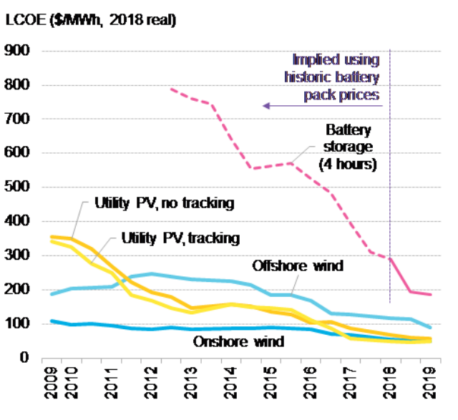The benchmark LCOE for offshore wind has dipped 24 percent.
The benchmark LCOE for onshore wind decreased 10 percent to $57 per megawatt-hour for projects starting construction in early 2019.
The benchmark LCOE for photovoltaic solar has dropped 18 percent to $57 per megawatt-hour for projects starting construction in early 2019.
BNEF analysis shows that the LCOE per megawatt-hour for onshore wind, solar PV and offshore wind have fallen by 49 percent, 84 percent and 56 percent respectively since 2010. That for lithium-ion battery storage has dropped by 76 percent since 2012, based on recent project costs and historical battery pack prices.
Elena Giannakopoulou, head of energy economics at BNEF, said: “The most striking finding in this LCOE Update, for the first-half of 2019, is on the cost improvements in lithium-ion batteries. These are opening up new opportunities for them to balance a renewables-heavy generation mix.”
Batteries co-located with solar or wind projects are starting to compete, in many markets and without subsidy, with coal- and gas-fired generation for the provision of dispatchable power that can be delivered whenever the grid needs it as opposed to only when the wind is blowing, or the sun is shining.
Tifenn Brandily, energy economics analyst at BNEF, said: “Solar PV and onshore wind have won the race to be the cheapest sources of new ‘bulk generation’ in most countries, but the encroachment of clean technologies is now going well beyond that, threatening the balancing role that gas-fired plant operators, in particular, have been hoping to play.”
Offshore wind has often been seen as a relatively expensive generation option compared to onshore wind or solar PV. Auction programs for new capacity, combined with much larger turbines, have produced reductions in capital costs, taking BNEF’s global benchmark for this technology below $100 per MWh, compared to more than $220 five years ago.
The low prices promised by offshore wind tenders throughout Europe are materializing, with several high-profile projects reaching financial close in recent months.
Though the LCOE of solar PV has dropped 18 percent in the last year, the majority of that decline happened in the third quarter of 2018, when a shift in Chinese policy caused there to be a huge global supply glut of modules.
BNEF said its LCOE analysis is based on information on projects starting construction and proprietary pricing information from suppliers. Its database covers nearly 7,000 projects across 20 technologies (including the various types of coal, gas and nuclear generation as well as renewables), situated in 46 countries.

